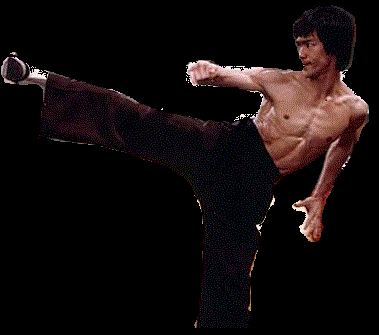
Bō
A bō (棒: ぼう), bong (Korean term), kon (Chinese term), or kun (Okinawan dialect), is a very tall and long staff weapon used in Okinawa and feudal Japan. Bō are typically around 1.8 m (71 in) long and used in Japanese martial arts, in particular bōjutsu. Other staff-related weapons are the jō which is 1.2 m (47 in) long and the hanbō (half bō, known as atahn bong in Korea) which is 90 cm (35 in) long.
Martial arts:
The Japanese martial art of wielding the bō is bōjutsu. The basis of bō technique is te, or hand, techniques derived from Quanfa and other martial arts that reached Okinawa via trade and Chinese monks. Thrusting, swinging, and striking techniques often resemble empty-hand movements, following the philosophy that the bō is merely an "extension of one’s limbs". Consequently, bōjutsu is often incorporated into other styles of empty hand fighting, such askarate.
The bō is typically gripped in thirds, and when held horizontally in front, the right palm is facing away from the body and the left hand is facing the body, enabling the bō to rotate. The power is generated by the back hand pulling thebō, while the front hand is used for guidance. When striking, the wrist is twisted, as if turning the hand over when punching[citation needed]. Bō technique includes a wide variety of blocks, strikes, sweeps, and entrapments. The bōmay even be used to sweep sand into an attacker’s eyes.
History:
The earliest form of the bō, a staff, has been used throughout Asia since the beginning of recorded history. The first bo were called ishibo, and were made of stone. These were hard to make and were often unreliable. These were also extremely heavy. The konsaibo was a very distant variant of the kanabo. They were made from wood studded with iron. These were still too cumbersome for actual combat, so they were later replaced by unmodified hardwood staffs. The bo used for self-defense by monks or commoners, the staff was an integral part of the Tenshin Shōden Katori Shintō-ryū, one of the martial arts’ oldest surviving styles. The staff evolved into the bōwith the foundation of kobudo, a martial art using weapons, which emerged in Okinawa in the early 17th century.
Prior to the 15th century, Okinawa, a small island located south of Japan, was divided into three kingdoms: Chuzan, Hokuzan, and Nanzan. After much political turmoil, Okinawa was united under the Sho Dynasty in 1429. In 1477, Emperor Sho Shin of the second Sho dynasty came into power. Determined to enforce his philosophical and ethical ideas, while banning feudalism, the emperor instituted a ban on weapons. It became a crime to carry or own weapons such as swords, in an attempt to prevent further turmoil and prevent uprising. In 1609, the temporary peace established by Sho Shin was violently overthrown when the powerful Satsuma Clan invaded Okinawa. Composed of Japanese samurai, the Satsuma Clan took over the island, making Okinawan independence a thing of the past. The Satsuma placed a new weapons ban on the people of Okinawa, leaving them defenseless against the steel of the samurai’s swords. In an attempt to protect themselves from the devastating forces of the Satsuma, the people of Okinawa looked to simple farming implements, which the samurai would not be able to confiscate, as new methods of defense. This use of weapons developed into kobudo, or "ancient martial way," as we know it today.
Although the bō is now used as a weapon, its use is believed by some to have evolved from the long stick (tenbin) which was used to balance buckets or baskets. Typically, one would carry baskets of harvested crops or buckets of water or milk or fish etc., one at each end of the tenbin, that is balanced across the middle of the back at the shoulder blades. In poorer agrarian economies, the tenbin remains a traditional farm work implement. In styles such as Yamanni-ryū or Kenshin-ryū, many of the strikes are the same as those used for yari ("spear") or naginata ("glaive"). There are stick fighting techniques native to just about every country on every continent.



